How DNA Testing Revealed European Ancestry in Elongated Paracas Skulls
The elongated skulls of Paracas in Peru caused a stir in 2014 when a geneticist that carried out preliminary DNA testing reported that they have mitochondrial DNA “with mutations unknown in any human, primate, or animal known so far”. A second round of DNA testing was completed in 2016 and the results almost as controversial – the skulls tested, which date back as far as 2,000 years, were shown to have European and Middle Eastern Origin. It was claimed these surprising results would change the known history about how the Americas were populated. But did they?
- Elongated Skulls in utero: A Farewell to the Artificial Cranial Deformation Paradigm?
- What Became of the Coneheads?
The Discovery of the Paracas Skull Graveyard
Paracas is a desert peninsula located within Pisco Province on the south coast of Peru. It is here where Peruvian archaeologist, Julio Tello, made an amazing discovery in 1928 – a massive and elaborate graveyard containing tombs filled with the remains of individuals with the largest elongated skulls found anywhere in the world. These have come to be known as the ‘Paracas skulls’. In total, Tello found more than 300 of these elongated skulls, some of which date back around 3,000 years.
- Possibly the Earliest Deliberate Cranial Deformations Found In China
- Pre-Mayan Remains found in Mexican Cave of Ancestors, Some Showing Cranial Deformation
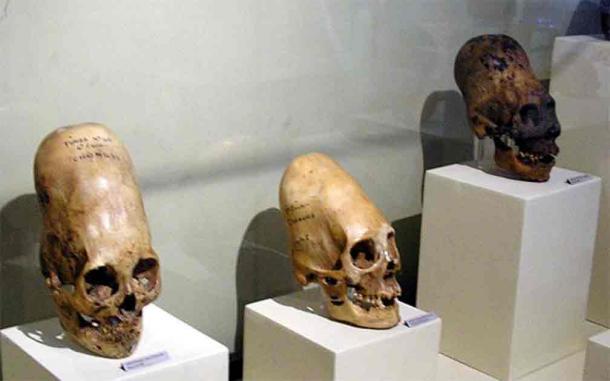
Elongated skulls on display at Museo Regional de Ica in the city of Ica in Peru (Marcin Tlustochowicz from Poland/CC BY 2.0)
Strange Features of the Paracas Skulls
It is well-known that most cases of skull elongation are the result of cranial deformation, head flattening, or head binding, in which the skull is intentionally deformed by applying force over a long period of time. It is usually achieved by binding the head between two pieces of wood, or binding in cloth. However, while cranial deformation changes the shape of the skull, it does not alter other features that are characteristic of a regular human skull.
In a 2016 interview with Ancient Origins, author and researcher LA Marzulli describes how some of the Paracas skulls are different to ordinary human skulls:
“There is a possibility that it might have been cradle head boarded, but the reason why I don’t think so is because the position of the foramen magnum is back towards the rear of the skull. A normal foramen magnum would be closer to the jaw line…”
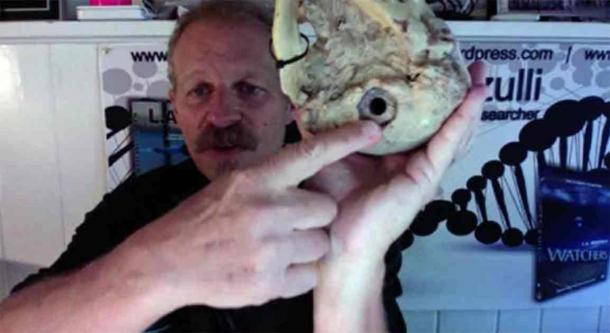
LA Marzulli points to the position of the foramen magnum in a Paracas skull which is also the point at which they drilled in order to extract bone powder for DNA testing. (Ancient Origins interview image)
Marzulli explained that an archaeologist has written a paper about his study of the position of the foramen magnum in over 1000 skulls:
“He states that the Paracas skulls, the position of the foramen magnum is completely different than a normal human being, it is also smaller, which lends itself to our theory that this is not cradle head boarding, this is genetic.”
In addition, Marzulli described how some of the Paracas skulls have a very pronounced zygomatic arch (cheek bone), different eye sockets and no sagittal suture, which is a connective tissue joint between the two parietal bones of the skull.
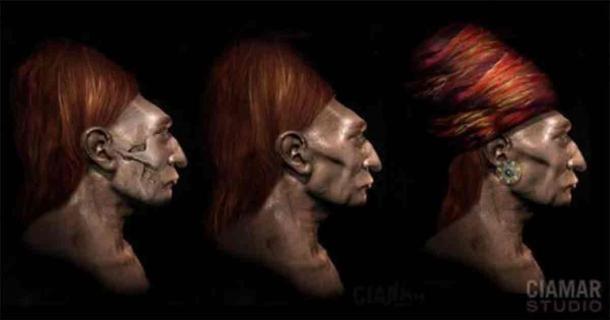
The pronounced cheek bones can be seen in artist Marcia Moore’s interpretation of how the Paracas people looked based on a digital reconstruction from the skulls. (Marcia Moore / Ciamar Studio)
“In a normal human skull, there should be a suture which goes from the frontal plate … clear over the dome of the skull separating the parietal plates - the two separate plates – and connecting with the occipital plate in the rear,” said Marzulli. “We see many skulls in Paracas that are completely devoid of a sagittal suture.
There is a disease known as craniosynostosis, which results in the fusing together of the two parietal plates, however, Marzulli said there is no evidence of this disease in the Paracas skulls.
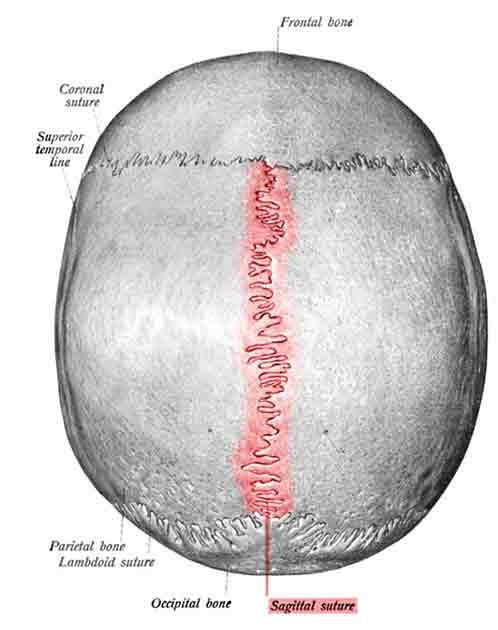
The sagittal suture, highlighted in red, separates the two parietal plates (Public Domain)

LA Marzulli shows the top of one of the Paracas skulls, which has no sagittal suture. (Ancient Origins interview image)
DNA Testing
The late Sr. Juan Navarro, owner and director of the Museo Arqueologico Paracas, which houses a collection of 35 of the Paracas skulls, allowed the taking of samples from three of the elongated skulls for DNA testing, including one infant. Another sample was obtained from a Peruvian skull that had been in the US for 75 years. One of the skulls was dated to around 2,000 years old, while another was 800 years old.
The samples consisted of hair and bone powder, which was extracted by drilling deeply into the foramen magnum. This process, Marzulli explained, is to reduce the risk of contamination. In addition, full protective clothing was worn.
The samples were then sent to three separate labs for testing – one in Canada, and two in the United States. The geneticists were only told that the samples came from an ancient mummy, so as not to create any preconceived ideas.

LA Marzulli holding up a replica of one of the Paracas skulls that was tested. (Ancient Origins interview image)
Surprising Results…or were they?
From the samples, only the mitochondrial DNA (DNA from the mother’s side) could be extracted. Out of four hair samples, one of them couldn’t be sequenced. The remaining three hair samples all showed a Haplogroup (genetic population group) of H2A, which is found most frequently in Eastern Europe, and at a low frequency in Western Europe. The bone powder from the most elongated skull tested came back as T2B, which originates in Mesopotamia and what is now Syria, essentially the heart of the fertile crescent. “It rewrites history as we know it,” said Marzulli.
“If these results hold,” writes Brien Foerster on his website Hidden Inca Tours, “the history of the migration of people to the Americas is far more complex than we have been told previously.”
If these results are confirmed through further tests, it means that peoples from Europe and the Middle East migrated to the Americas long before it is conventionally believed. This is a huge discovery, and yet as far as Ancient Origins can establish, no further testing has been done.
Marzulli said that mainstream academics will probably attack these results by pointing to the fact that he is not a scientist, but he urges any skeptic to replicate the study.
“Attack the evidence folks. Go down and get your own samples, pay for a DNA lab and then come back to me with your science… do some science like we’ve done,” he said.
The full lab reports of the DNA tests are available in LA Marzulli’s book Nephilim Hybrids.
Now, although these results do seem surprising, DNA native to Europeans found in native Americans is not unique too this DNA result.
In an article, published in 2013 (before this testing) about DNA found in Native Americans, linking them with Europe. The report writes:
‘’…from the complete nuclear genome of a Siberian boy who died 24,000 years ago - the oldest complete genome of a modern human sequenced to date. His DNA shows clse ties to those of today’s Native Americans. Yet he apparently descended not from East Asians, but from people who had arrived in Europe or Western Asia…the finding suggests that about a third of the ancestry of today’s Native Americans can be traced to ‘western Eurasia’”
As mainstream archaeology states South America was populated by migration south from North America (around 16-19000 years ago), it is perhaps not such a surprise to find European DNA in South American DNA, just has been found in North American DNA.
The Debate Continues
In the YouTube video "Complete Examination of the Ancient Paracas People of Peru Including DNA Results and Blood Tests,", first aired in 2017, Brian Forester details his thoughts on the results of the DNA testing which he and his associates commissioned.
He reports that the results revealed that four of the elongated skulls belonged to Hao Group B, indicating Native American ancestry, while the other skulls did not match this group. The most common Hao groups identified were U2e and H1a, which are predominantly found in the Black Sea and Caspian Sea areas.
Forestago,suggests that the Paracas people may have originated from the Caucasus region around 3,000 years ago and migrated to the coast of Peru. This proposal points to a significant ancient migration pattern, revealing European and Eurasian haplogroups, which challenges conventional academic views.
But What About the Hair?
The results could help explain the fact that many of the Paracas skulls still contain traces of red hair, a color that is not natively found in South America but originates in the Middle East and Europe.
“No academics as far as we can tell can explain why some of the skulls that still have hair are red or even blonde,” writes Brien Foerster, “the idea that this is from time or bleaching has NOW been disproven by 2 hair experts. For the ancient Paracas people, at least, they had blonde to reddish hair that is 30% thinner than NATIVE American hair. It is GENETIC!”

A Paracas skull with its red hair. ( Brien Foerster)
Just to Mention the Extra-terrestrial Hypothesis
Due to the unusual shape and features of the Paracas skulls, there has long been speculation that they are extra-terrestrial in origin, and many have hoped that DNA testing would prove that to be the case.
“As regards an “alien” component or ancestry to the skulls, we may never know,” writes Brien Foerster. “The DNA testing programs can only compare sample DNA with those that are known, and those are held in a huge database called Gentech in the US. Further testing with cooperation from Peruvian archaeologists and the Ministry of Culture are ongoing.”
Nevertheless, LA Marzulli explained that the DNA results fit perfectly with the hypothesis he has held since before any testing was undertaken. That is that the Paracas people are the Nephilim. The Nephilim, according to ancient Biblical texts, are the offspring of the Fallen Angels and the women of earth, resulting in a hybrid entity, and they said to be based in the area of the Levant, the same place that the Paracas DNA traces to.
Whether or not this hypothesis has any merit, the results of the DNA tests were certainly dramatic, and further testing may help to unravel the complex history of the Paracas people.

Top image: A Paracas elongated skull and an artist’s impression based on a digital reconstruction. Source: Marcia Moore / Ciamar Studio
This article was updated on 21-5-2024 to add further details from the 2013 Science report.















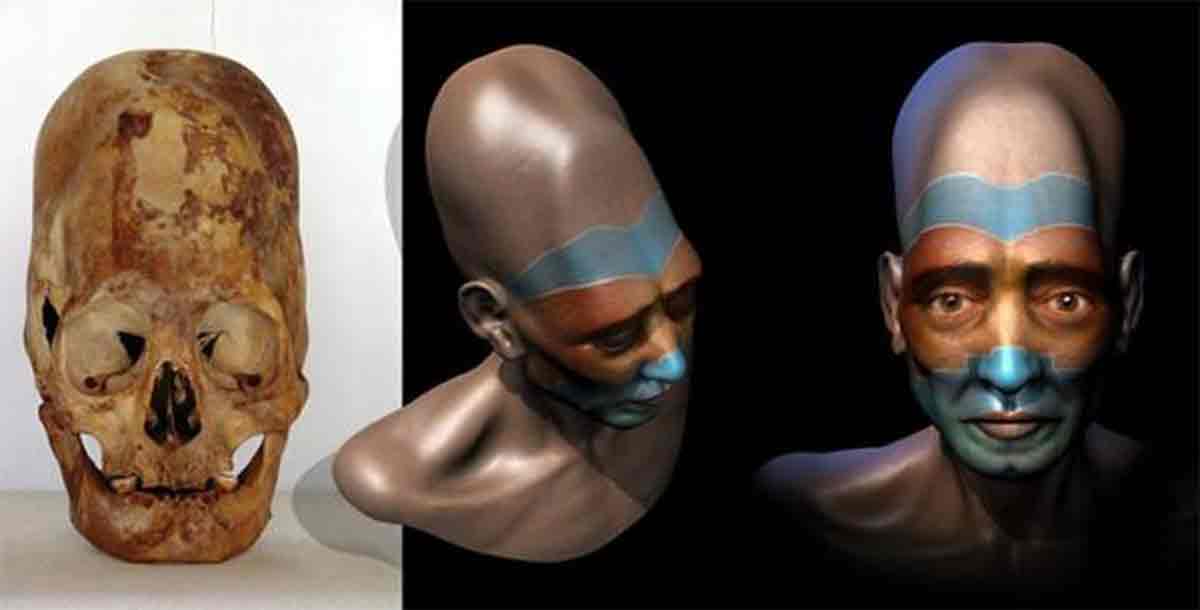

Comments
Well it appears that when ever a discussion arises regarding ancient Black civilizations, it always brings out white racist individuals in opposition of the historical facts, so therefoire, your question should be addressed to those white racist individuals, and not to the general public as a whole regarding Black racial historical facts. By grouping the two sides as being one and the same obviously shows bias, and partiality for one group who always post comments in an attempt to deny the truth.. Comparing the two groups the same as when Donald Trump stated a few year ago when a peaceful white female BLM Proester was murdered by white supemacist groups in Charlottesville , North Carolina, when he stated that “THERE WERE GOOD PEOPLE ON BOTH SIDES”, when there were actually “BAD PEOPLE” on one side who were violently attacking “GOOD PROTESTERS” who were advocating for “EQUAL JUSTICE” in an American predominantly white racist society. None of the peaceful protestors murdered any of the “wanna be” white superiors, while it was a very LOW IQ white supremacist who used his automobile to run over and murder a white female peaceful protester. So therefore, the two should have never benen compared, same as the racists who always rush over like TROLLS to try denying importance of ancient Black civilizations, regardless if they are Black Carthaginians, Nubians/Egyptians, Ethiopans, Punt, Black Minoans, Etruscans, Chaldeans, Colchians, etc.. While it is true that no person alive today are a eyewitness to any historical events that occurred before our lifetime, that s why we study historical written documents, statues, paintings, coins, artifacts, statements made by scholars who did live during those historical times as being truths...Otherwise, what is history suppose to be...
Charles Bowles
Reading the comments on ancient DNA is always hilarious yet totally embarrassing as it's usually guaranteed to descend into a modern Black vs White mess of presumed racial superiority (on both sides). And which just makes people look like total bumpkins, pretending you were actually there living alongside these ancient people plus understanding all the complexities of DNA. Which none of us really do. I’m glad some things are a mystery. It puts modern people back in their boxes, where they perhaps should be, until they can all learn to look at the past through unbiased and non-prejudicial eyes. We may all be surprised!
Duplicated in error.Deleted.
Well, Pete wagner, the Sumerians did call themselves ‘BLACK HEADED PEOPLE”, and not “black haired people”, which is a total difference… Since he Sumerians knew the difference between “HAIR” and “HEAD” ha ha ha.. The Black Sumerians also referred to themselves as the “CIVILIZED PEOPLE”, which was meant to distinguish themselves from the Barbaric “Uncivilzed” people who surrounded them in the Caucasus area, and who would often conduct roguish and violent attacks to steal various products such as jewelry, horseback saddles, etc, which they had no knowledge about producing, then race back to the outlying hills of the Caucasus mountains with such goods..
Charles Bowles
More likely they are the race that was destroyed prior to the arrival of the Anunnaki (the black-headed people). The question becomes, did the Anunnaki have anything to do with their demise? We do of course know that the surface of the Earth was decimated by the event that caused the Ice Age (100k year nuclear winter) long before the so-called 'dawn of civilization' in Sumer, where the ancient texts describe Sumerians laying mud bricks upon the megalith stone ruins, obviously suggesting the existence of an earlier ill-fated ADVANCED civilization. Add a zero to Plato’s timeline (recognizing the common devious tactic of removing zeros from datelines/ancient texts to obscure the truth) and the destruction of Atlantis/Richat Structure fits the theory very well, and suggests a fair-haired race possibly were the true aboriginal Earthings. Sumerians would probably NOT have called themselves the 'black-headed people' were there other black-haired people on Earth when they arrived.
Nobody gets paid to tell the truth.
Pages